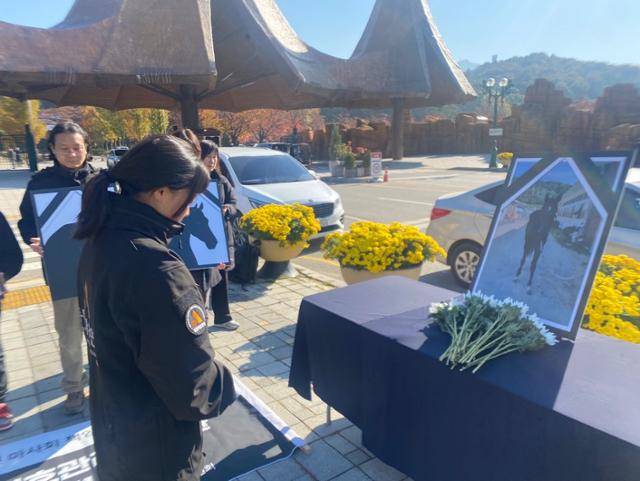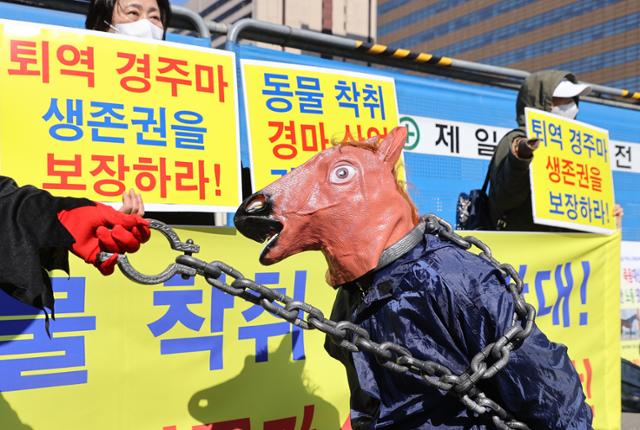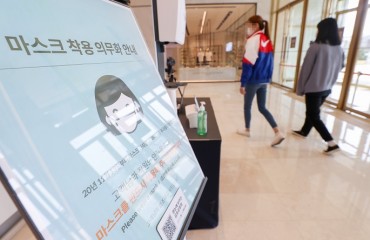
Mariage, who died in an accident while filming a historical drama, was a retired racehorse who had only raced three times. He never won a race and was sold just three months after his retirement, ultimately leading to his death at the age of five. (Image provided by KOREAN ANIMAL WELFARE ASSOCIATION)
SEOUL, Nov. 9 (Korea Bizwire) – In 2021, a retired racehorse named Mariage met a tragic end during the filming of a scene for the KBS drama “The King of Tears, Lee Bangwon.” Three years later, as animal rights advocates gathered to commemorate the horse’s death, promised reforms for animal performer protection remain largely unrealized.
“Dear Mariage, Kami! I’ll always remember you, sacrificed by selfish and cruel humans. I’m so sorry we couldn’t protect you. I pray you’re resting peacefully in heaven,” wrote one citizen in a social media post to the Korean Animal Welfare Association, using the horse’s stage name, Kami.
The incident, which sparked public outrage when footage emerged of the horse being deliberately tripped by ropes, led to government and Korea Racing Authority (KRA) promises to establish performer animal protection guidelines and implement a comprehensive horse tracking system.
However, three years later, both initiatives have stalled, raising concerns about the potential for similar incidents.
These concerns appear justified following the recent discovery of deceased and severely malnourished retired racehorses at a farm in Gongju, South Chungcheong Province. Some of these horses had previously earned hundreds of millions of won in prize money during their racing careers.
On November 7, a coalition of 16 animal welfare organizations, including the Beagle Rescue Network and Korean Animal Welfare Association, held a press conference outside the KRA headquarters in Gwacheon, Gyeonggi Province, commemorating Mariage’s death while demanding accountability for the Gongju incident.

On 7 November, on the third anniversary of Mariage’s death, animal rights groups held a press conference in front of the Korea Racing Authority in Gwacheon, Gyeonggi Province, to commemorate Kami (Mariage’s nickname). The ‘National Task Force to Establish Equine Welfare’ is made up of 16 organisations, including the Beagle Rescue Network and the Korean Animal Welfare Association. (Photo provided by Animal Welfare Korea)
The promised guidelines, which were supposed to include basic principles, filming protocols, and species-specific considerations, have yet to materialize. While the drama director, stunt coordinator, and Mariage’s owner were found guilty of violating animal protection laws and fined 10 million won in January, the owner has appealed the decision, with a hearing held on November 7.
The mandatory horse tracking system also remains unimplemented. Currently, horse owners are not required to register retired racehorses’ destinations in the horse industry information portal. Consequently, over 10% of retired horses annually are classified as “purpose undefined,” with many cases of mismatched locations and uses.
“In the past five years, an average of 1,300 racehorses retire annually, yet they continue to be bred for racing under policy support,” the coalition stated. “Half of retired horses die, and hundreds more become untraceable.” They pointed out that the European Union requires “horse passports” for all horses and urged South Korea to implement similar lifetime tracking measures.
Kim Se-hyun, a representative of the Beagle Rescue Network, cited the case of “Cheonji’s Light,” a racehorse that received support from the KRA for a transition to recreational riding but was later found abandoned at the Gongju site. “The KRA and government must now take responsibility and establish proper horse welfare policies,” Kim said.
The Ministry of Agriculture, Food and Rural Affairs announced plans to develop horse welfare measures by year-end, including enhanced tracking systems and life-cycle support. A ministry official stated that research for implementing the horse tracking system would begin next year, noting that 2.7 billion won has been allocated for government financial and welfare support this year.
The ministry is also considering including media performance guidelines within their planned horse-specific welfare guidelines, though no concrete timeline has been provided for their implementation.

Members of the Korea Association for Animal Protection and other animal rights groups perform during a press conference to call for the right to survival of retired racehorses at Gwanghwamun Square in Seoul, South Korea, on the afternoon of 23 February 2022. (Image courtesy of Yonhap)
Lina Jang (linajang@koreabizwire.com)






